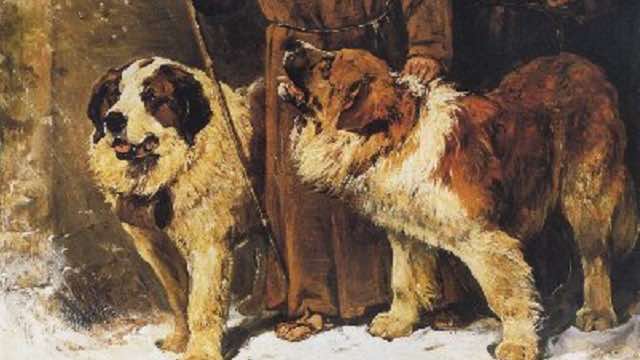If you’ve seen a single Beethoven movie, you’d probably know the dog breed we’re talking about. Yes, those huge lovable, and cuddly dogs. But did you know they were not always called Saint Bernards?
Saint Bernards were originally known as Barry Hounds. They were named after a dog named “Barry” who lived at the Saint Bernard hospice in the 1800s. Barry saved 40 people in the mountains, including a half-frozen child.
Barry the Saint Bernard
Even after two centuries, Barry the Saint Bernard is still famous all over the world. Barry de Menschenretter worked as a mountain rescue dog in Switzerland and Italy at the Great St. Bernard Hospice. Compared to the Saint Bernard we are familiar with today, Barry was much lighter and lean.
The first mention of the dog in the Great St. Bernard Hospice archives was dated in 1707. The records say a dog was buried by us. The dogs were introduced to the monastery as watchdogs between 1660 and 1670. Old skulls from the Natural History Museum of Bern show that two kinds of dogs lived in the hospice during that time.
Barry was born in the 1800s. During his life, he was credited for saving the lives of more than forty people. Though there has been some discrepancy in the exact number of people he saved, what we know for sure is that it didn’t go below forty.
His most notable save was a young boy. He found the child asleep in a cavern of ice, and after warming him up, he carried him onto his back and brought him to the hospice for medical attention. The boy survived and was returned to his parents.
The best of dogs, the best of animals is Barry. You used to leave the convent with a basket round your neck, into the storm, in the most insidious snow. Each and every day you examined the mountain searching for unfortunates buried under avalanches. You dug them out and brought them back to life by yourself and, when you couldn’t, you rushed back to the convent signalling the monks for help. You resurrected people. Your tenderness was so easy to communicate, that the boy you dug out had no fear to let you bring him, holding on to your back, to the Hospice.
Peter Scheitlin, Complete Study on Animal Instinct
(Source: Swiss Info)
What Happened to Barry?
In the Cimetiere de Chiens pet cemetery in France, there is a plaque that says; Il sauva la vie à 40 personnes. Il fut tué par le 41 ème. This translates to; He saved the lives of forty people. He was killed by the forty-first.
As the legend goes, news had spread that a Swiss soldier got lost in the mountains. Barry searched for the soldier and picked up his scent. In about 48 hours or so, he found the soldier in a large ice bank. He dug the soldier out and started to lick him, as he was trained to do. When the Swiss soldier woke up, he was startled at the sight of Barry. He thought Barry was a wolf, and on instinct, stabbed him with his bayonet. There were even versions of the story where Napoleon was said to be the soldier who stabbed poor Barry.
However, the story of his death was far less dramatic than you would have thought. The truth is, after 12 long years of service to the monastery, Barry was brought by a monk to Bern, Switzerland, to live out the rest of his life. Barry passed away at the age of 14. His body was sent to the Natural History Museum of Bern, where a special exhibition was held in his honor to commemorate his 200th birthday. (Source: Swiss Info)
